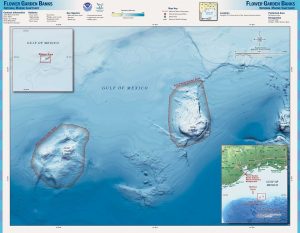Welcome to my coral reefs blog! This semester I’ll be blogging periodically about the Flower Garden Banks National Marine Sanctuary, a coral reef in the Northern Gulf of Mexico that is notable for being one of few reefs along the United States coastline. The focus of my blog will be on the conservation status and general health of the Flower Garden Banks, and will discuss the major threats to the reef as well as the key components that keep the reef’s rich and complex ecosystem functioning.
Before we can start talking about these main issues, it’s important to have a clear picture of what the Flower Garden Banks look like. Over millions of years, salt deposits, known as salt domes, deep underneath the seafloor of the Gulf of Mexico rose up until they almost breached the water’s surface1. These mounds of salt formed the foundation that enabled coral colonies to develop. This topography, while crucial, is not the only thing needed to build a reef. A variety of factors such as water temperature, salinity, nutrient profile, wave energy, and even sedimentation must all lie within specific vital ranges for corals to live and grow. In the case of the Flower Garden Banks, these conditions have not only all been achieved, but have also persisted for millions of years- long enough for the vibrant reefs we know about today to form!
The Flower Garden Banks Sanctuary actually consist of three separate reefs: East Flower Garden banks, West Flower Garden banks, and Stetson Bank. These reefs, along with their proximity to one another and with reference to the Gulf coast, can be seen on the map below. Due to their relative proximity to one another, these three reefs are considered as a single system. These reefs are less than 200km from the Texas coast, making them a convenient location for someone looking to go reef-diving without travelling across the world (as long as the correct steps are taken to ensure the reef is treated well and left pristine). Compared to other Caribbean or Gulf of Mexico Reefs, the Flower Garden Banks have relatively low diversity in terms of coral species, with the boulder star coral (pictured below) comprising about half of the live coral cover and a handful of other species comprising the rest3.

Note the relative positions of the East and West Banks as well as Stetson Bank to eachother and to the Texas coastline. The salt domes are visible as raised topographical features within the seafloor basin.
By: NOAA, National Marine Sanctuaries – http://www.sanctuaries.noaa.gov/pgallery/atlasmaps/fg.html, Public Domain, https://commons.wikimedia.org/w/index.php?curid=1284294
Despite this relatively low coral diversity, the Flower Garden Banks exhibit a very rich diversity of other species, including algae, sponges, crustaceans and other invertebrates, and almost 300 species of fish3! A handful of ray species can also be observed year-round. The corals and surrounding topography provide sustenance and shelter for countless species which in turn create even more ecological relationships and further boost biodiversity, although human interference such as fishing can quickly destabilize these relationships and threaten the health of the reef2.

Boulder Star Coral (Montastraea annularis) with parrotfish bite scars. This is the dominant reef building coral of the Flower Garden Banks.
By: George Stoyle, Flickr Creative Commons, https://www.flickr.com/photos/georgestoyle/5844308723/in/photolist-9UrBnv-9s4yaA-9UrGJe-krqLZJ-BgZzrp-5TKXWx-8a6Qna-fKfC16-qjFSNV-446EjW-bUedkM-Hr5Qon-qnCz1D-yrAi1z-eJBkEn-7Jj9hG-dN3vhu-qidZC6-h3uem-G9unLJ-uzzozR-q7Y5jf-7j481A-7tCWJf-e9aQa6-cPkvHw-8yQB6W-pd6QHK-he2JrF-9x9NCA-Jbeuc-h61RTA-dLeJSX-h626h7-9UrBsF-9UrBEg-9UrBzg-drbQMp-7TViNn-drc1ts-NwEb3x-9tFuUv-Fncsiq-drc1nj-drc1mh-6MfiPD-drc1h7-drbQs8-drc1ks-drbQJM
Although the outlook for coral reefs around the world is grim and worsening over time, the Flower Garden Banks are one of the world’s most pristine and untouched reefs3. The Banks have been the subject of close monitoring for decades4. Live coral cover, one of the best measures of reef health, is high at all three banks. Since the reefs started being monitored in the 1970s, incidences of coral disease, bleaching, and die-offs has been lower than the global average3. Investigating the reasons for success of the Flower Garden banks could give insight into how to conserve other reefs which are struggling. The clock is ticking for many of our planet’s coral reefs, and we are at a very real risk of losing one of nature’s most priceless and beautiful phenomena. As we closely monitor the health of the Flower Garden banks and study the patterns of reef death and growth, we should look for the ways in which we can apply this knowledge to reef conservation efforts globally.
References:
- “Introduction to Flower Garden Banks National Marine Sanctuary.” Flower Garden Banks National Marine Sanctuary. National Ocean Service, n.d. Web. 20 Feb. 2017.
- Clark, Randy, Chris Taylor, Christine Buckel, and Laura Kracker. “Fish and Benthic Communities of the Flower Garden Banks National Marine Sanctuary: Science to Support Sanctuary Management.” NOAA Technical Memorandum NOS NCCOS 179 (n.d.): n. pag. Web.
- Schmahl, George P. “Status of the Flower Garden Banks of the Northwestern Gulf of Mexico.” Flower Garden banks National Marine Sanctuary. National Ocean Service, n.d. Web.
- Gittings, S.r., K.j. Deslarzes, G.s. Boland, and T.j. Bright. “Ecological Monitoring At The Texas Flower Garden Coral Reefs.” American Academy of Underwater Sciences (n.d.): n. pag. Web.

